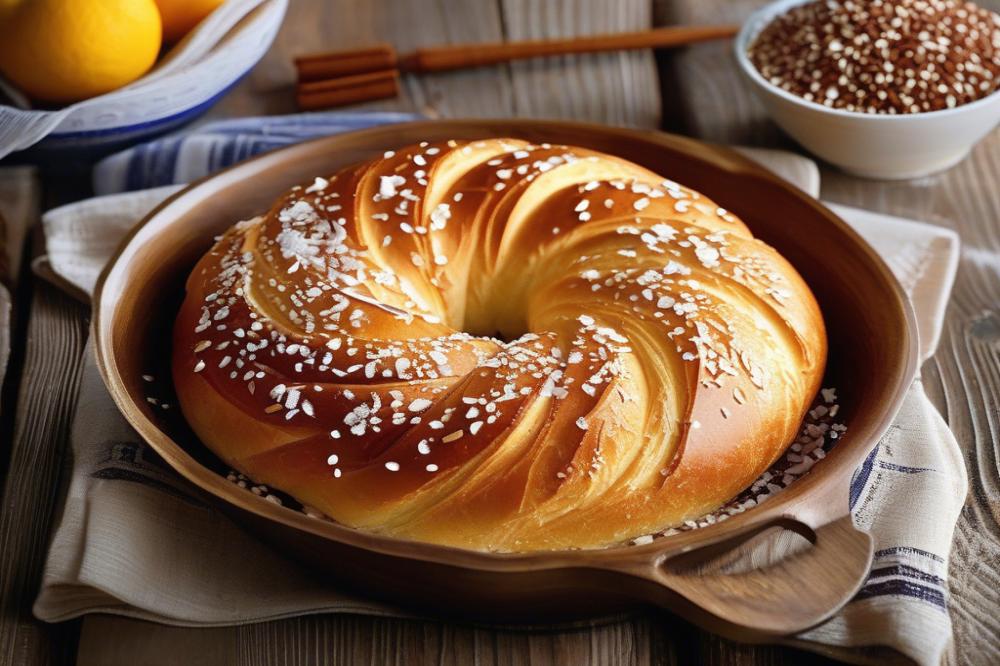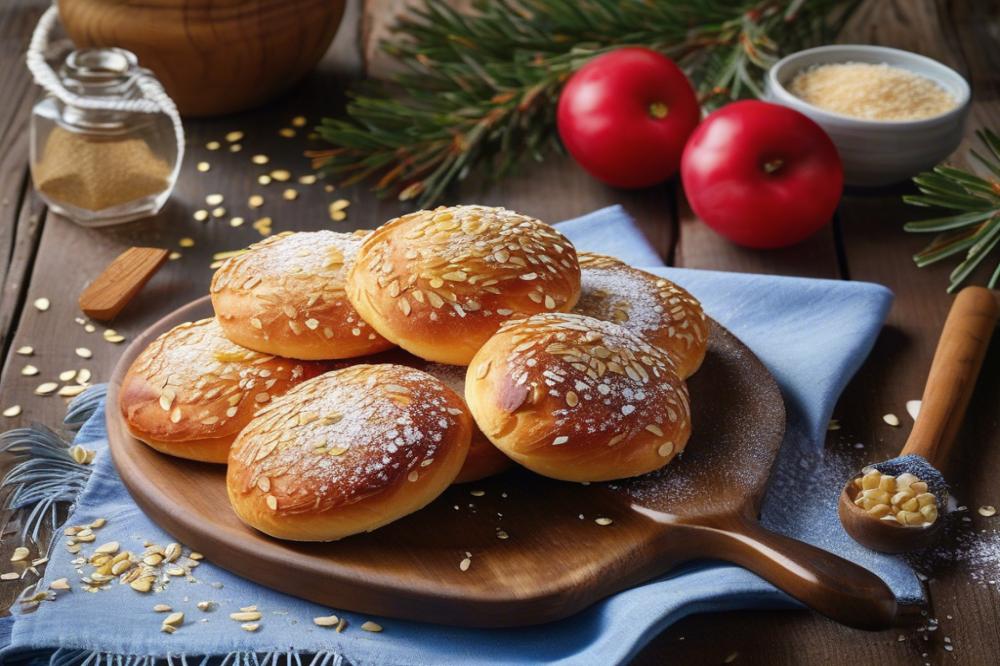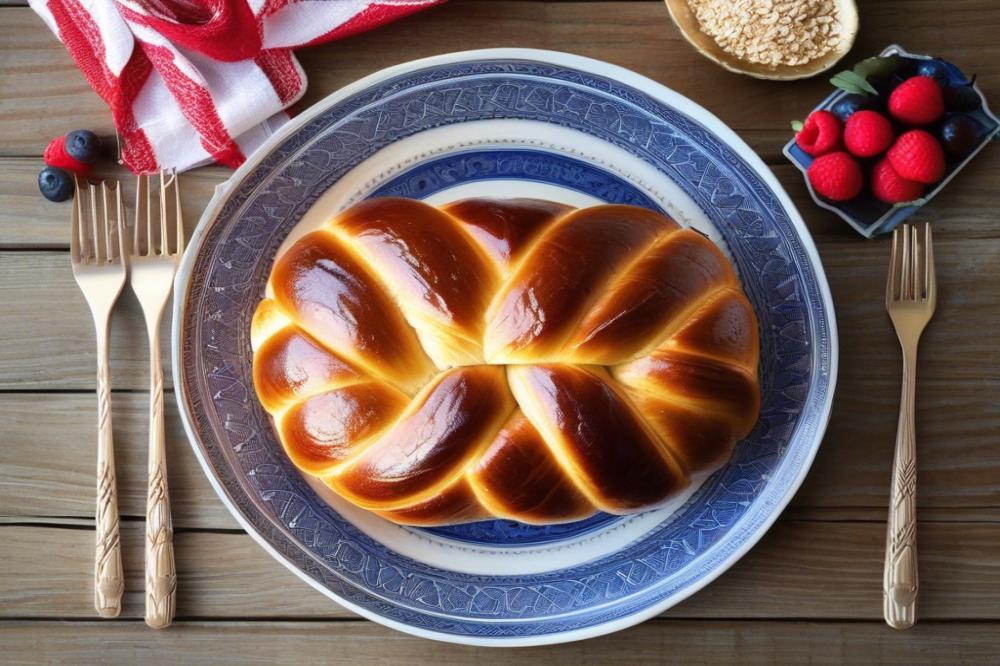Introduction
recipebix.com/the-perfect-recipe-for-kok-greek-chocolate-coated-cakes”>Greek Tsoureki is a classic dessert that evokes warm memories of family gatherings and festive occasions. This delightful sweet bread boasts rich flavors that dance on the palate, making it a beloved treat during the Easter season. Each bite reveals the essence of tradition, infused with the aromatic notes of mahleb, fragrant orange zest, and a hint of cinnamon.
The significance of Tsoureki goes beyond its delicious taste. This braided bread symbolically represents the resurrection and the joy of spring. During the Easter festivities, families come together to prepare and share this special recipe, often adorning the bread with red-dyed eggs, which add a visual charm to the celebration.
Baking Tsoureki is an art. The dough requires careful kneading and patience to rise properly. The braided form, with its beautiful golden crust, is not just appealing to the eye; it also adds to the overall texture. The combination of flavors makes each loaf distinct, inviting everyone to savor a piece of Greek culture.
What is Greek Tsoureki?

History and Cultural Significance
Greek Tsoureki is more than just a sweet bread; it represents a deep connection to Greek tradition and culture. Often enjoyed during Easter, it symbolizes the end of fasting. Families gather to bake this festive bread, passing recipes down through generations. The process of making Tsoureki brings loved ones together, fostering a sense of community. Each loaf is not only a treat but also a story that unfolds during celebrations.
Comparison with Other Types of Bread and Desserts
Unlike standard bread, the texture of Tsoureki is soft and slightly sweet. This unique quality comes from ingredients like sugar and milk. Other breads might focus solely on acidity or density. In contrast, this sweet bread stands out for its warm, inviting aroma. Additionally, many desserts have a more pronounced sweetness or heavy richness. Tsoureki balances sweetness with the fragrance of spices. Those familiar with cinnamon and orange zest will find those flavors prominently featured in this recipe.
Variations of Tsoureki Across Regions in Greece
Different regions of Greece add their special touches to Tsoureki. In some areas, a hint of mahleb enhances the flavor, giving it a distinctive taste. Others prefer richer spices or additional ingredients like nuts. The method of braiding the dough can also change from one area to another. Traditional Greek recipes reflect local customs and available resources. Each variation represents the unique identity of its region, contributing to Greece’s culinary diversity. The holiday spirit is evident in every loaf produced, regardless of the local twist.
Ingredients and Measurements

The journey to create authentic Greek Tsoureki starts with gathering the right ingredients. Below is a list of what you will need, along with their quantities. Each component plays a vital role in delivering the rich flavor and delightful texture of this traditional Greek braided bread.
- 4 cups all-purpose flour
- 1 cup milk
- 1/2 cup sugar
- 1/2 cup unsalted butter
- 3 large eggs
- 2 teaspoons active dry yeast
- 1/2 teaspoon salt
- 2 teaspoons mahleb
- 1 tablespoon orange zest
- 1 teaspoon cinnamon
- Sesame seeds for topping
With these ingredients, you’ll create a festive bread that’s perfect for celebrations. The mahleb adds a unique flavor, reminiscent of sweet cherries. Orange zest gives an aromatic touch that brightens the bread. Cinnamon brings warmth to the overall taste.
Nutritional Information
Understanding the nutritional breakdown can help with meal planning. Below is the estimated content for each ingredient. Keep in mind that these values can vary based on specific brands and preparations.
- All-purpose flour (4 cups): Approximately 1,840 calories, 4g fat, 392g carbohydrates, 56g protein
- Milk (1 cup): About 150 calories, 8g fat, 12g carbohydrates, 8g protein
- Sugar (1/2 cup): Roughly 400 calories, 0g fat, 104g carbohydrates, 0g protein
- Unsalted butter (1/2 cup): Estimated 800 calories, 88g fat, 0g carbohydrates, 0g protein
- Eggs (3 large): Approximately 210 calories, 15g fat, 1g carbohydrates, 18g protein
- Active dry yeast (2 teaspoons): About 20 calories, 0g fat, 5g carbohydrates, 2g protein
- Salt (1/2 teaspoon): 0 calories, 0g fat, 0g carbohydrates, 0g protein
- Mahleb (2 teaspoons): Roughly 20 calories, 1g fat, 4g carbohydrates, 0g protein
- Orange zest (1 tablespoon): Approximately 3 calories, 0g fat, 1g carbohydrates, 0g protein
- Cinnamon (1 teaspoon): About 6 calories, 0.1g fat, 2g carbohydrates, 0g protein
- Sesame seeds (for topping): Estimated 15 calories, 1.2g fat, 1.5g carbohydrates, 0.5g protein
In total, this recipe brings together complex flavors and a medley of textures, ideal for festive gatherings. baking this sweet bread links tradition with the joy of sharing. Get ready to indulge in a creation that warms both the heart and the table.
Cooking Instructions

Activating the Yeast
Start by gathering your ingredients. You will need warm milk, sugar, and yeast. Combine the warm milk with some sugar in a small bowl. Add the yeast and stir gently. Let this sit for about ten minutes. Watch for bubbles or foam to form. This means your yeast is alive and ready to go!
Preparing the Dough
In a large mixing bowl, mix flour, salt, and more sugar. Create a well in the center of this mixture. Pour in your activated yeast mixture along with eggs, melted butter, and flavoring. For a traditional Greek touch, add some mahleb, orange zest, and a dash of cinnamon. These spices will enhance the bread’s aroma and taste.
Kneading and Rising
Once combined, begin kneading the dough on a lightly floured surface. Work the dough for about ten minutes until it becomes smooth and elastic. After kneading, place the dough in a greased bowl. Cover it with a clean kitchen towel. Allow it to rise in a warm place for about one hour. It should double in size.
Braiding the Dough
After the dough has risen, punch it down gently to release air. Divide the dough into three equal pieces. Roll each piece into long strands, about a foot in length. Line up the strands and braid them together. Make sure to tuck the ends neatly. This will create a beautiful, braided bread shape.
Final Rise and baking
Place the braided dough on a baking sheet lined with parchment paper. Cover it again with a towel and let it rise for another thirty to forty minutes. Preheat your oven to 350°F (175°C) during this time. Once the dough has risen, you can optionally brush it with egg wash for a golden crust. Bake for about thirty to thirty-five minutes. The bread should turn a deep golden brown.
Cooling and Serving
Remove the baked bread from the oven and let it cool on a wire rack. This step is important to maintain its texture. Once cool, slice the tsoureki and serve it warm or at room temperature. This festive bread makes an excellent accompaniment to many dishes. Enjoy with family and friends, especially during Easter!
Flavoring and Variations

When making authentic Greek Tsoureki, flavoring is key to achieving its rich, aromatic profile. Traditional flavoring agents include mahleb, orange zest, and cinnamon. Mahleb is a spice made from the seeds of wild sour cherries. Its nutty and slightly bitter notes add depth to the bread. Orange zest brings a bright, citrusy quality that lifts the overall flavor. Alongside this, cinnamon weaves in warmth and sweetness, making the bread feel cozy and inviting.
In addition to these classic flavors, bakers often explore alternative variations. Nutmeg can be used to enhance the warmth, providing a hint of spice. Meanwhile, lemon zest gives a refreshing twist that contrasts beautifully with the sweetness of the dough. Some might even mix these zest options, creating a blend that captures the essence of both fruits. These variations allow for creative expression while respecting the spirit of Greek traditions.
Understanding the cultural significance of these flavors in Greek cuisine adds another layer to the experience. Each agent reflects a connection to the land, celebrating the vibrant Mediterranean lifestyle. During special occasions, such as Easter, the use of these ingredients in making braided breads transforms the Tsoureki into a festive bread. Families often gather to bake together, making it not just a recipe, but a cherished ritual. Each bite carries memories, love, and centuries of culinary history, bringing people together around the table.
Serving and Enjoying Tsoureki
Traditional Ways to Serve Tsoureki
Freshly baked Greek Tsoureki often takes center stage during festive occasions. Slices of this braided bread can be enjoyed plain or with a sprinkle of powdered sugar. It’s also delightful when served with butter or jam. Serving it slightly toasted brings out its rich flavors even more. Pairing this sweet bread with a cup of coffee is a common practice. Some people prefer it warm, enhancing its tempting aroma.
Pairing Suggestions with Drinks or Other Desserts
Certain drinks complement the flavors of Tsoureki beautifully. Anise-flavored beverages, like ouzo or rakomelo, provide a nice contrast to the sweetness. Hot tea or a refreshing herbal tea can also be great choices. For dessert lovers, serving a slice alongside vanilla ice cream or a dollop of whipped cream adds a satisfying touch. Chocolate or fruit-based desserts can serve as great companions as well.
Role of Tsoureki in Greek Celebrations and Gatherings
Tsoureki plays a significant role in Greek celebrations, especially during Easter. Families gather to share this festive bread, marking the end of Lent with joy. It symbolizes renewal and the sweetness of life after fasting. Birthdays and weddings also feature this beloved treat. The bread’s unique flavoring, including mahleb, orange zest, and cinnamon, contributes to its special status. Sharing Tsoureki creates moments of joy and connection among friends and family.
Final Thoughts on Tsoureki Baking
Celebrated during festive occasions, Tsoureki holds a special place in Greek culture. This sweet bread is not just a treat; it symbolizes the joy of togetherness and tradition. Families often gather to share this delicious bread during Easter and other celebrations, making it a central part of their gatherings.
Trying your hand at making this traditional recipe at home can be rewarding. The process of mixing, kneading, and baking becomes a way to connect with history and family roots. Even if you have never baked bread before, this is a wonderful opportunity to create something special.
Creating Tsoureki allows you to explore the flavors and aromas of Greece in your kitchen. The hands-on experience can be both fun and fulfilling. Imagine the delight on your loved ones’ faces when they taste your homemade creation!
Baking traditional Greek recipes serves not only to provide nourishment but also to preserve memories and celebrate culture. As you embark on this culinary adventure, remember that every loaf tells a story. Enjoy the journey, savor the process, and embrace the joy that comes with sharing delicious food with others. Happy baking!



